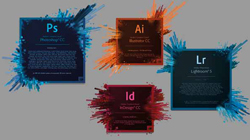articles/Software/Adobe-Creative-Cloud-page1
Adobe Creative Cloud - part 1 of 1 2 3 4 5 6 7
by Mike McNamee Published 01/02/2014

Unfortunately a review of Adobe's Creative Cloud at the present time is more about the politics and less about the technicalities. Up until now (actually mid 2013) Adobe had a policy of software upgrades, usually on an 18-month cycle (give or take). Additionally, various elements of their product portfolio used to be upgraded on cycles that were out of synch with each other. This made good sense, depending upon the maturity of a product, the ability or need to upgrade was variable. This changed with the introduction of the Creative Suite concept in which all upgrades were launched at the same time. This had the advantage of one big set of launch gigs to organise and additionally the users were offered significant cost reductions when they purchased a bundle of products (typically 'Design Standard', 'Web Standard' and the like). This synchronisation had the effect of stressing both development and sales. The engineers had to be ready to go, with no time compromises (and bugs that this might allow through), and the sales people saw an upturn in activity for a short period followed by a lull. The fact that the suites contained both mature and newer products meant that some parts of the suite contained significant new features, others were more cosmetic - all had to be paid for regardless of whether the individual user was interested in them. Slathered on top of all this was the obvious fact that the key software of the suites, Photoshop, has matured into such a huge product that people cannot cope with what is already on offer let alone any new 'killer' features. Adobe for their part were forced (for example) to headline a change in the interface colour from light grey to dark grey - a change for the worst in any case (the very first thing you need to do is change it back to light grey if you care about screen-to-print matching!).
One early tactic adopted by Adobe was to force the users to upgrade by only facilitating the opening of current Raw files backwards for two versions. Thus a new camera drove the need to upgrade whether the user needed the new features or not. So it came to pass as the original nay sayers of open source Raw had predicted, the Raw file had become a exploitation, commercial tool for things other than processing your images.
Grumbling about such things were nought compared with the firestorm that greeted the arrival of the 'subscription only' model of using (not owning!) Adobe software. A petition in excess of 30,000 was reached by June 2013 and some really vitriolic posts were appearing in various forums. Adobe were being given extremely hostile receptions at events such as Photoshop World with sacrificial speakers pushed onto stage to be greeted with hissing every time the word Adobe was mentioned.
Now this model of software use is not new, indeed most of the serious engineering design and analysis programs such as Pro Engineer and Catia have always been rented out on a 'per-seat' basis. Significantly such software has also remained very stable, no fancy GUI changes for these guys, they dare not risk bringing the entire car design industry to a grinding halt with buggy software! The comparison is interesting when stood alongside Steve Jobs' quote: "I have my own theory about why the decline happens at companies like IBM or Microsoft. The company does a great job, innovates and becomes a monopoly or close to it in some field, and then the quality of the product becomes less important. The product starts valuing the great salesmen, because they're the ones who can move the needle on revenues, not the product engineers and designers. So the salespeople end up running the company."
You are currently on page 1
- Adobe Creative Cloud page 1
- Adobe Creative Cloud page 2
- Adobe Creative Cloud page 3
- Adobe Creative Cloud page 4
- Adobe Creative Cloud page 5
- Adobe Creative Cloud page 6
- Adobe Creative Cloud page 7
1st Published 01/02/2014
last update 09/12/2022 14:50:51
More Software Articles
There are 0 days to get ready for The Society of Photographers Convention and Trade Show at The Novotel London West, Hammersmith ...
which starts on Wednesday 15th January 2025





